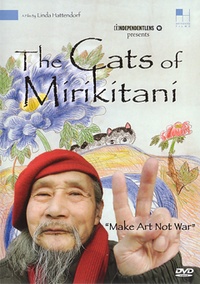I recently sat down for a long overdue viewing of the documentary The Cats of Mirikitani. (Darryl Mori has written an excellent and thorough review of the film in a previous Discover Nikkei article—please check it out!)
I am a bit of a documentary addict, and this film stands out among other films of the genre because it is so deeply personal and poignant. The filmmaker, Linda Hattendorf, portrays her subject, octogenarian artist Jimmy Tsutomu Mirikitani, at arguably the highest and lowest points of his life. As she develops a friendship with him, the details of his fascinating life unfold.
I was surprised to discover that Jimmy Mirikitani lived and created art in Greenwich Village during the same time period in which I attended NYU. Although I unfortunately do not recall seeing him or his art, we shared the very same New York City neighborhood. During the course of the film, I frequently found myself recognizing the street scenes that served as his backdrop. I am disappointed to have learned of Mirikitani’s story only recently because he is so directly relevant to my studies in art history, Asian American studies, and Asian American contemporary art. I had been living in such close proximity to someone who was a striking embodiment of everything I was learning about – what a missed opportunity! (NYU’s A/P/A Studies Institute has since displayed an exhibition of his art, a few years after I graduated.) In any case, I am thankful that the film now exists to introduce his life and his work to those of us who did not come across him when he lived and worked on the streets of New York.
Although the details of Jimmy Mirikitani’s life were largely unknown to me, there were elements of his extraordinary story that were instantly familiar. He is a kibei Nisei, born in northern California but educated in Japan, much like my grandparents. Critical of the American government’s violation of JA citizens’ constitutional rights during World War II, he was incarcerated at Tule Lake, the very same camp as my family. But unlike my grandparents and more like me, he eventually left California and moved to New York. While the events of World War II (including the loss of his family in Hiroshima) clearly defined much of his life thereafter, he and I share an experience that has deeply impacted my life and those of the many other New Yorkers -- that of living in downtown New York during the World Trade Center attacks. As I watched the scenes filmed on September 11, 2001, in which the artist creates a drawing of the towers as they are still burning in the background, I vividly recalled walking down the very same street on which the scene was filmed on that exact day, after the buildings had fallen. It was simultaneously moving and unsettling for me to watch the footage and recall that imagery. My reaction is a testament to the magic of documentary filmmaking -- its ability to capture significant moments as they happen.
The Cats of Mirikitani reminded me of a simple yet powerful concept that has been swimming around in my head ever since I took my first ethnic studies class. That concept is, simply put, that history is being made every day by you, me, and the people around us. Mirikitani’s story might have been lost had it not been for the curiosity and concern of a documentary filmmaker. While learning about history is definitely important, the present is also key. Let’s remember to look around, observe and appreciate the stories of those around us, and take a moment to consider the part we are playing in what will one day become history.
© 2008 Simone Momoye Fujita





